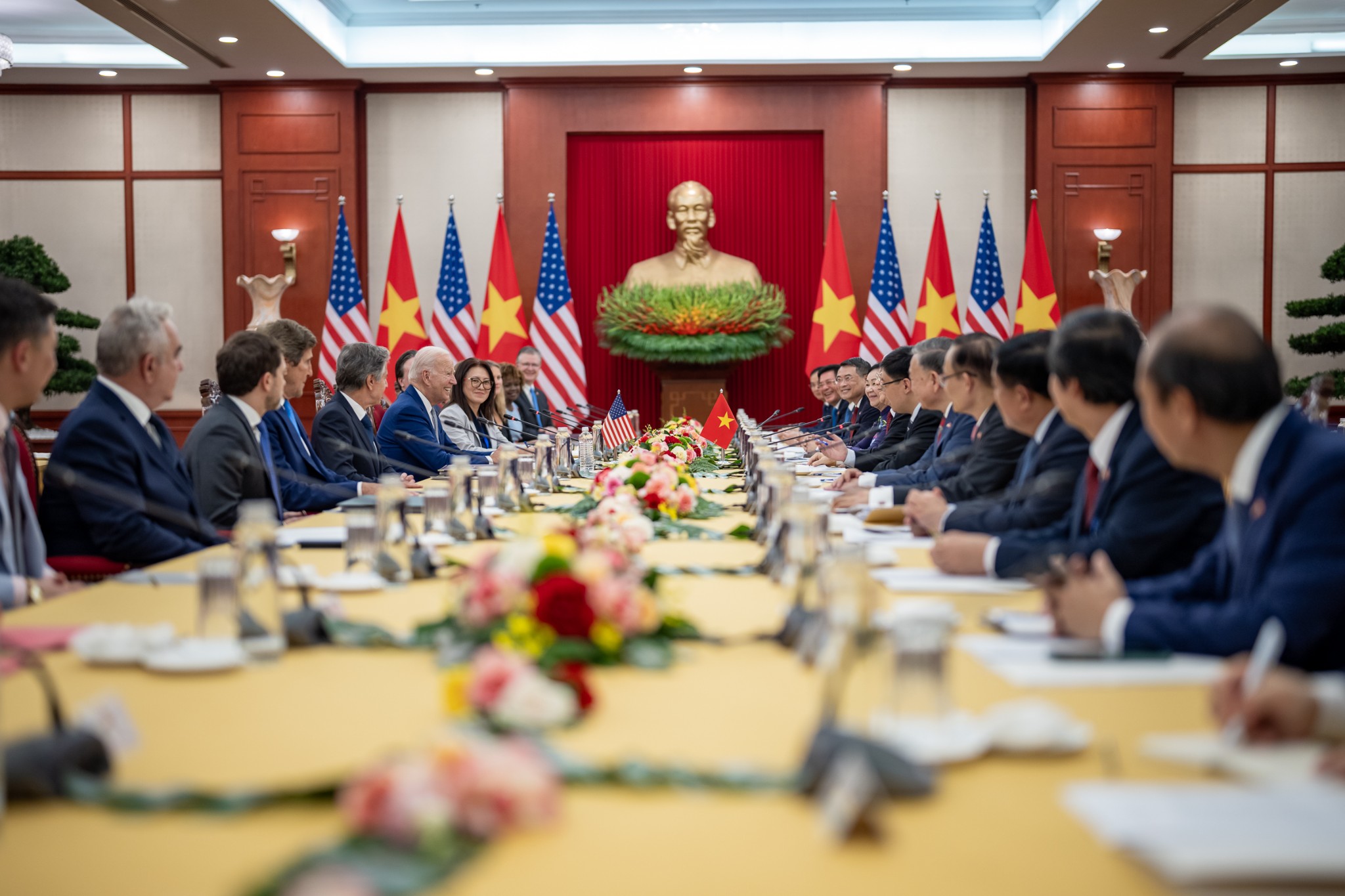 U.S. President Joe Biden talks with Vietnam President Võ Văn Thưởng via @POTUS X
U.S. President Joe Biden talks with Vietnam President Võ Văn Thưởng via @POTUS X
The Russian Paradox at the Heart of U.S.-Vietnam Relations
President Joe Biden’s visit to Vietnam this September harkened in a new era of American-Vietnamese relations, as Vietnam designed its relationship with the United States as a “comprehensive strategic partnership.” One day before the visit, it was uncovered that Vietnam was in secret talks to buy an $8 billion arsenal of Russian weapons in flagrant violation of American sanctions. Russia’s continuing relations with Vietnam show a paradox in today’s great power competition. While Vietnam aligns itself with the U.S. in opposition to China, it has continued its historically deep relations with Russia, even as Russia and China align themselves against American interests. Vietnam needs to gradually scale back its strategic partnership with Russia due to the growing Russian and Chinese collaboration, Russia’s doubtful position as a long-term military supplier, and the escalating tensions between the three great powers.
Vietnam’s foreign policy, termed the “Three Noes,” is based on balancing its ties with the primary global powers. By maintaining friendly relations with Russia, China, and the U.S., the “Three Noes“—no military alliances, no military bases of foreign countries in Vietnam, and no reliance on one country—aim to prevent economic and military dependence on any partner. Despite this policy, however, Russia and Vietnam have an extensive history of interdependence. During the Vietnam War, the Soviet Union supported North Vietnam while the U.S. supported the South. Since the Cold War, Vietnam has been a major military partner of Russia and has purchased most of its military equipment from them.
China and Vietnam have a more sordid history complicated by China’s pursuit of regional hegemony. China has long claimed vast amounts of the South China Sea, including Vietnam’s claims to the Paracel and Spratly Islands. The South China Sea is a vital shipping route, a top fishing destination, and a source of substantial natural resources. China has rapidly expanded its island-building and naval patrols, leading to clashes with Vietnamese shipping and fishing vessels. China’s aggression has pushed Vietnam towards the U.S., as the U.S. does not recognize China’s claims.
This means that Vietnam is facing a dilemma where Russia, its main ally, is aligning with China, its main rival. In February 2022, China and Russia announced a “no limits partnership” against the U.S. The partnership has continued to grow as China buys Russian energy while Russia buys Chinese goods. A no-limits partnership is problematic for Vietnam because, as China continues to interfere in the South China Sea, it may force Russia to decide between its partners.
Russia’s position as a long-term military supplier is also in doubt. Leaked American documents report that the Russian invasion of Ukraine has rapidly depleted its military inventory, and the country is now using much older munitions. The records also estimate that Russia has lost over 2,000 tanks in the war so far. These losses are reflected in reports that North Korea will sell millions of its old munitions to Russia. Russian military exports have declined since the mid-2010s, and the Ukraine war has hastened this decline as any domestic production has gone into the war effort, and the war has displayed the technological limitations of Russian equipment.
Vietnam’s dilemma is unenviable, and maintaining bilateral relations with all three countries is rapidly becoming less feasible. In 2017, Congress passed the Countering America’s Adversaries Through Sanctions Act, which sanctioned countries that purchased Russian military equipment. This was the first of many restrictions that would come to pass over the war in Ukraine. Vietnam abstaining from a UN vote against Russia regarding the Ukraine War in February shows how the country is trying to balance relations between the U.S. and Russia, but this balancing act is becoming unsustainable. As it deepens ties with both states, Vietnam may be unable to simultaneously appeal to Russian and American interests.
As China’s vie for regional hegemony pushes it from one sphere to another, Vietnam finds itself in a partially perilous position. However, there is good news: despite Vietnam’s close relations with Russia, the U.S. is putting these strategic ties aside in pursuit of new partners in the Indo-Pacific. In the future, both the U.S. and Vietnam will have to prioritize and compromise. To secure Vietnam as a partner against China, the U.S. might have to tolerate the country’s neutrality in the Ukraine War and look the other way toward Russian weapons sales, lest Vietnam determine that America’s demands are too great and hedge itself with Russia and China. In the long term, however, Vietnam may have to decouple its military from Russia, breaking from its Three Noes. But if it must temporarily hitch its horse to one cart, it should pick the U.S. over Russia.





